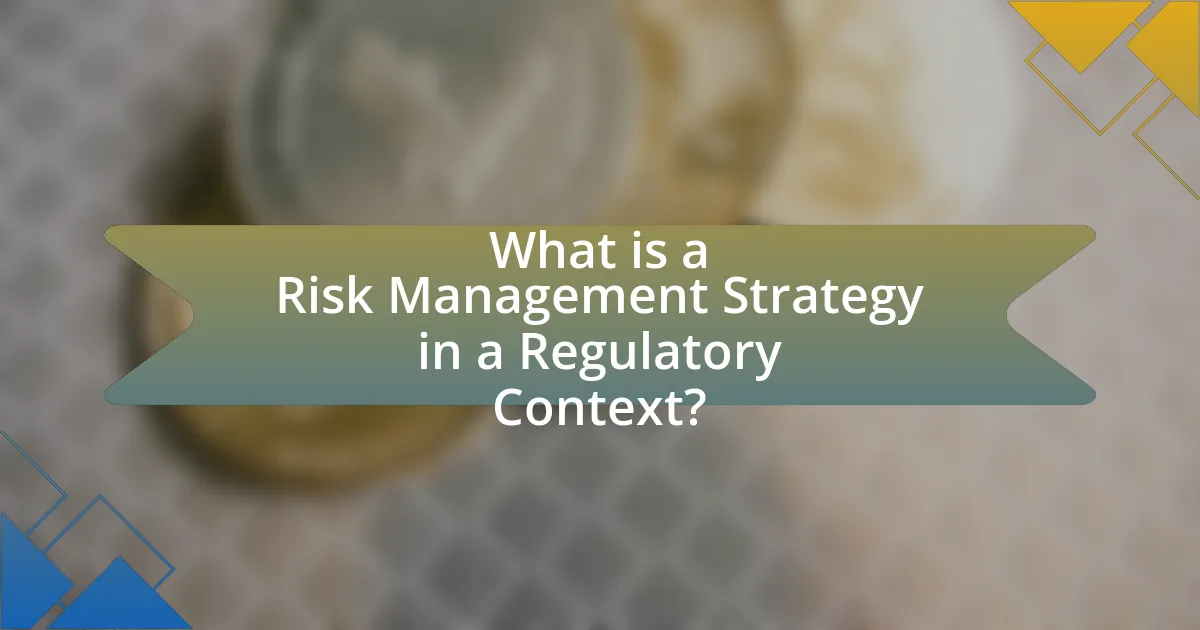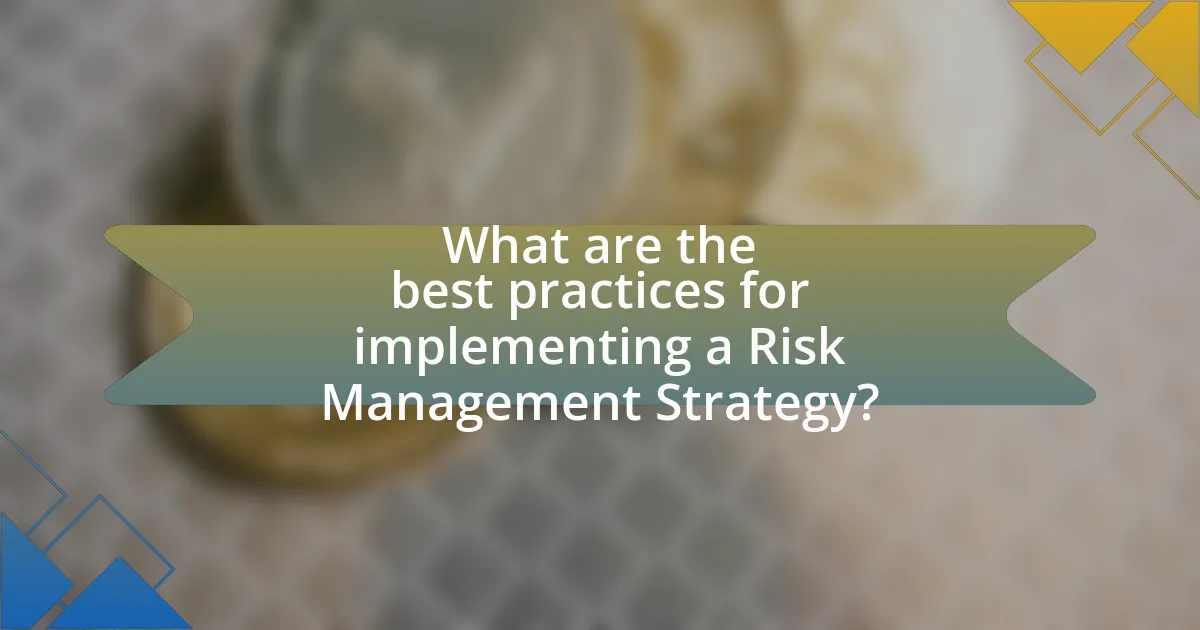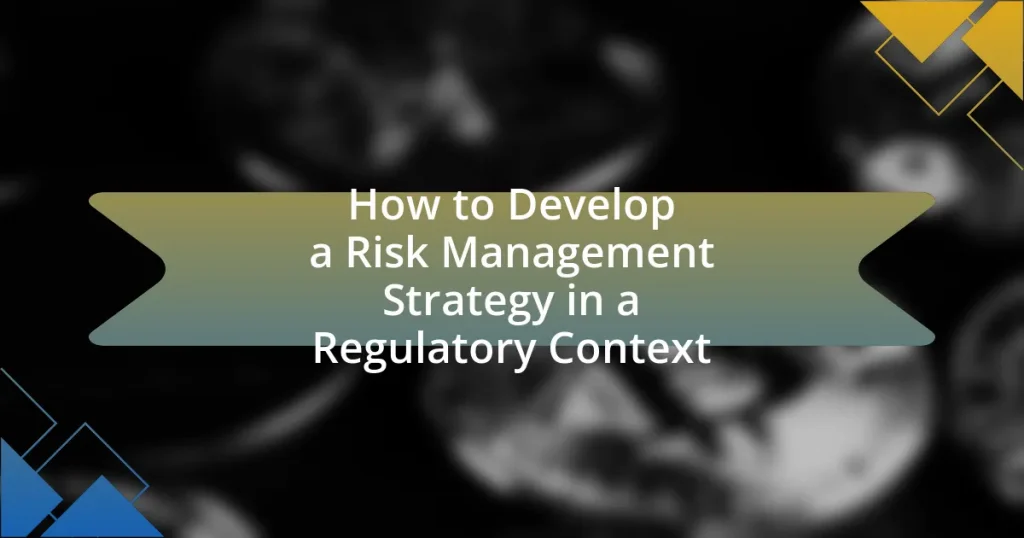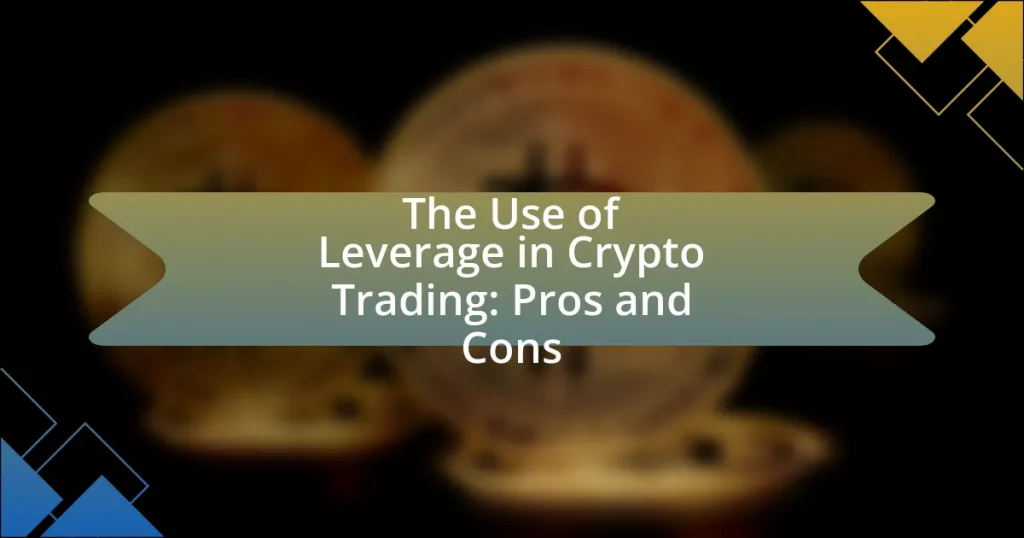A Risk Management Strategy in a Regulatory Context is a systematic approach that organizations utilize to identify, assess, and mitigate risks related to regulatory compliance. This article outlines the essential components of such a strategy, including risk identification, assessment, mitigation, monitoring, and communication, while emphasizing the influence of regulations on its development. It also discusses the importance of stakeholder engagement, best practices for implementation, and ongoing processes necessary for maintaining an effective risk management framework. Furthermore, the article highlights the potential consequences of inadequate risk management and provides practical tips for organizations to enhance their compliance efforts in a dynamic regulatory environment.

What is a Risk Management Strategy in a Regulatory Context?
A Risk Management Strategy in a Regulatory Context is a structured approach that organizations use to identify, assess, and mitigate risks associated with regulatory compliance. This strategy involves establishing processes and controls to ensure adherence to laws, regulations, and standards relevant to the organization’s operations. For example, financial institutions implement risk management strategies to comply with regulations such as the Dodd-Frank Act, which mandates risk assessment and reporting to prevent systemic failures. By integrating risk management into their compliance frameworks, organizations can proactively address potential regulatory breaches, thereby minimizing legal liabilities and enhancing operational resilience.
How does a Risk Management Strategy function within regulatory frameworks?
A Risk Management Strategy functions within regulatory frameworks by ensuring compliance with legal and industry standards while identifying, assessing, and mitigating risks. This strategy aligns organizational practices with regulations such as the Sarbanes-Oxley Act, which mandates risk assessment and internal controls, thereby safeguarding against financial misreporting. Additionally, frameworks like ISO 31000 provide guidelines for integrating risk management into governance processes, ensuring that organizations systematically address risks in a manner that meets regulatory expectations. By adhering to these frameworks, organizations can enhance their risk management capabilities, reduce potential liabilities, and maintain operational integrity.
What are the key components of a Risk Management Strategy?
The key components of a Risk Management Strategy include risk identification, risk assessment, risk mitigation, risk monitoring, and communication. Risk identification involves recognizing potential risks that could impact objectives, while risk assessment evaluates the likelihood and impact of these risks. Risk mitigation focuses on developing strategies to reduce or eliminate risks, and risk monitoring ensures ongoing evaluation of risk management effectiveness. Lastly, communication is essential for informing stakeholders about risks and management strategies. These components are critical for organizations to navigate regulatory requirements effectively and maintain compliance.
How do regulations influence the development of a Risk Management Strategy?
Regulations significantly influence the development of a Risk Management Strategy by establishing mandatory compliance requirements that organizations must adhere to. These regulations dictate the frameworks and processes that organizations must implement to identify, assess, and mitigate risks effectively. For instance, financial institutions are required to follow the Basel III framework, which mandates specific capital requirements and risk management practices to enhance financial stability. This regulatory pressure compels organizations to develop comprehensive risk management strategies that align with legal standards, ensuring that they not only protect their assets but also maintain operational integrity and avoid penalties.
Why is a Risk Management Strategy important in a regulatory context?
A Risk Management Strategy is crucial in a regulatory context because it ensures compliance with laws and regulations, thereby minimizing legal and financial penalties. Regulatory bodies often require organizations to identify, assess, and mitigate risks to protect stakeholders and maintain market integrity. For instance, the Sarbanes-Oxley Act mandates that publicly traded companies implement internal controls to manage financial risks, demonstrating the legal obligation to have a robust risk management framework. This strategy not only safeguards the organization against potential violations but also enhances its reputation and operational resilience in a complex regulatory landscape.
What are the potential consequences of inadequate risk management?
Inadequate risk management can lead to significant financial losses, regulatory penalties, and reputational damage for organizations. For instance, a study by the Institute of Risk Management found that companies with poor risk management practices are 50% more likely to experience financial distress. Additionally, inadequate risk management can result in operational disruptions, as seen in the 2017 Equifax data breach, which cost the company over $4 billion in total damages and fines. Furthermore, organizations may face legal liabilities and loss of customer trust, which can have long-term impacts on business sustainability and growth.
How does effective risk management enhance compliance?
Effective risk management enhances compliance by systematically identifying, assessing, and mitigating risks that could lead to regulatory violations. This proactive approach ensures that organizations adhere to legal requirements and industry standards, thereby reducing the likelihood of non-compliance penalties. For instance, a study by the Institute of Risk Management found that organizations with robust risk management frameworks are 50% less likely to experience compliance breaches. By integrating risk management into compliance strategies, organizations can create a culture of accountability and continuous improvement, ultimately fostering a more compliant operational environment.

What steps are involved in developing a Risk Management Strategy?
The steps involved in developing a Risk Management Strategy include identifying risks, assessing risks, developing risk mitigation strategies, implementing the strategies, monitoring and reviewing the strategies, and communicating the risk management process.
Identifying risks involves recognizing potential threats that could impact the organization. Assessing risks requires evaluating the likelihood and impact of these threats. Developing risk mitigation strategies entails creating plans to minimize or eliminate identified risks. Implementing the strategies involves putting the plans into action. Monitoring and reviewing the strategies ensures that the risk management process remains effective and relevant over time. Finally, communicating the risk management process keeps all stakeholders informed and engaged.
These steps are essential for creating a comprehensive risk management strategy that aligns with regulatory requirements and organizational objectives.
How do you identify risks in a regulatory environment?
To identify risks in a regulatory environment, organizations must conduct a comprehensive risk assessment that includes analyzing regulatory requirements, industry standards, and potential compliance gaps. This process involves reviewing relevant laws and regulations, such as the Sarbanes-Oxley Act or GDPR, to understand the specific obligations and risks associated with non-compliance. Additionally, organizations should engage in stakeholder interviews and surveys to gather insights on perceived risks and historical compliance issues. By systematically documenting and prioritizing these risks, organizations can develop a clear understanding of their regulatory landscape and the potential impacts on their operations.
What tools can be used for risk identification?
Tools that can be used for risk identification include risk assessment matrices, checklists, brainstorming sessions, interviews, and software applications designed for risk management. Risk assessment matrices help visualize and prioritize risks based on their likelihood and impact, while checklists ensure that all potential risks are considered systematically. Brainstorming sessions encourage team collaboration to identify risks creatively, and interviews with stakeholders provide insights into specific risks related to their areas of expertise. Additionally, specialized software applications streamline the risk identification process by automating data collection and analysis, enhancing accuracy and efficiency in identifying potential risks.
How do you assess the impact of identified risks?
To assess the impact of identified risks, one must evaluate the potential consequences and likelihood of each risk affecting the organization. This involves categorizing risks based on their severity and the probability of occurrence, often using a risk matrix to visualize and prioritize them. For instance, a study by the Project Management Institute indicates that organizations that utilize structured risk assessment methodologies can reduce project failure rates by up to 30%. This structured approach allows for informed decision-making and resource allocation, ensuring that the most critical risks are addressed effectively.
What role does stakeholder engagement play in developing a Risk Management Strategy?
Stakeholder engagement is crucial in developing a Risk Management Strategy as it ensures that diverse perspectives and insights are incorporated into the risk assessment process. Engaging stakeholders allows organizations to identify potential risks more comprehensively, as stakeholders often possess unique knowledge about specific areas of concern. For instance, a study by the Project Management Institute found that projects with high stakeholder engagement are 20% more likely to succeed, highlighting the importance of collaboration in risk identification and mitigation. By actively involving stakeholders, organizations can enhance the effectiveness of their risk management strategies and foster a culture of shared responsibility for risk.
Who are the key stakeholders in the risk management process?
The key stakeholders in the risk management process include senior management, risk management teams, employees, regulatory bodies, and external auditors. Senior management is responsible for setting the risk management framework and ensuring alignment with organizational objectives. Risk management teams implement strategies to identify, assess, and mitigate risks. Employees contribute by adhering to policies and reporting potential risks. Regulatory bodies establish compliance requirements that organizations must follow, while external auditors evaluate the effectiveness of risk management practices. Each stakeholder plays a critical role in ensuring a comprehensive approach to risk management, which is essential for maintaining regulatory compliance and organizational resilience.
How can stakeholder feedback improve the strategy?
Stakeholder feedback can improve strategy by providing insights that align the strategy with the needs and expectations of those affected by it. Engaging stakeholders allows organizations to identify potential risks and opportunities that may not be apparent internally, leading to more informed decision-making. For instance, a study by the Harvard Business Review found that companies that actively seek stakeholder input are 30% more likely to achieve their strategic goals. This feedback loop fosters transparency and trust, ultimately enhancing the effectiveness and adaptability of the strategy in a regulatory context.

What are the best practices for implementing a Risk Management Strategy?
The best practices for implementing a Risk Management Strategy include establishing a clear framework, conducting thorough risk assessments, engaging stakeholders, and continuously monitoring and reviewing risks. A clear framework provides structure and guidance, ensuring that all aspects of risk management are addressed systematically. Conducting thorough risk assessments allows organizations to identify, analyze, and prioritize risks effectively, which is essential for informed decision-making. Engaging stakeholders ensures that diverse perspectives are considered, enhancing the strategy’s relevance and effectiveness. Continuous monitoring and reviewing of risks enable organizations to adapt to changing circumstances and improve their risk management processes over time. These practices are supported by the ISO 31000 standard, which emphasizes the importance of a structured approach to risk management in achieving organizational objectives.
How can organizations ensure compliance with regulatory requirements?
Organizations can ensure compliance with regulatory requirements by implementing a comprehensive compliance management system. This system should include regular audits, employee training, and the establishment of clear policies and procedures that align with relevant regulations. For instance, a study by the Compliance and Ethics Institute found that organizations with robust compliance programs are 50% less likely to experience regulatory violations. Additionally, utilizing technology for monitoring and reporting can enhance compliance efforts by providing real-time data and analytics, ensuring that organizations can quickly adapt to regulatory changes.
What are the common challenges faced during implementation?
Common challenges faced during implementation include resistance to change, inadequate training, and lack of stakeholder engagement. Resistance to change often stems from employees’ fear of the unknown, which can hinder the adoption of new processes. Inadequate training can lead to misunderstandings of the new system, resulting in errors and inefficiencies. Additionally, lack of stakeholder engagement can result in insufficient support and resources, making it difficult to align the implementation with organizational goals. These challenges are frequently documented in studies on change management, highlighting their impact on successful implementation outcomes.
How can organizations measure the effectiveness of their Risk Management Strategy?
Organizations can measure the effectiveness of their Risk Management Strategy by evaluating key performance indicators (KPIs) such as the frequency and severity of risk incidents, compliance with regulatory requirements, and the overall impact on organizational objectives. For instance, a reduction in the number of incidents or losses over time indicates improved risk management effectiveness. Additionally, organizations can conduct regular audits and assessments to ensure adherence to established risk management frameworks, such as ISO 31000, which provides guidelines for effective risk management practices. These assessments can reveal gaps in the strategy and highlight areas for improvement, thereby validating the effectiveness of the risk management approach.
What ongoing processes are necessary for maintaining a Risk Management Strategy?
Ongoing processes necessary for maintaining a Risk Management Strategy include continuous risk assessment, regular monitoring of risk controls, and periodic review of the risk management framework. Continuous risk assessment involves identifying new risks and evaluating existing ones to ensure they are still relevant and adequately managed. Regular monitoring of risk controls ensures that the measures in place are effective and functioning as intended. Periodic review of the risk management framework allows organizations to adapt to changes in regulations, business environments, and emerging risks, ensuring the strategy remains robust and compliant. These processes are essential for effective risk management and compliance with regulatory requirements.
How often should a Risk Management Strategy be reviewed and updated?
A Risk Management Strategy should be reviewed and updated at least annually. This frequency ensures that the strategy remains relevant and effective in addressing new risks and changes in the regulatory environment. Regular reviews, supported by industry best practices, help organizations adapt to evolving threats and compliance requirements, thereby enhancing overall risk management effectiveness.
What role does training play in sustaining risk management efforts?
Training is essential for sustaining risk management efforts as it equips personnel with the necessary skills and knowledge to identify, assess, and mitigate risks effectively. Regular training ensures that employees remain updated on regulatory changes, best practices, and emerging risks, which is crucial in a dynamic regulatory environment. For instance, organizations that implement ongoing training programs report a 30% increase in risk awareness and a 25% reduction in compliance violations, demonstrating the direct impact of training on risk management effectiveness.
What practical tips can help in developing a Risk Management Strategy in a regulatory context?
To develop a Risk Management Strategy in a regulatory context, organizations should conduct a comprehensive risk assessment to identify potential regulatory risks. This assessment should include analyzing existing regulations, understanding compliance requirements, and evaluating the impact of non-compliance, which can lead to significant financial penalties and reputational damage.
Additionally, organizations should establish a clear governance structure that defines roles and responsibilities for risk management, ensuring accountability at all levels. Regular training and awareness programs for employees about regulatory changes and compliance obligations are essential to foster a culture of compliance.
Implementing a robust monitoring and reporting system allows organizations to track compliance status and identify emerging risks promptly. Finally, engaging with regulatory bodies and industry groups can provide valuable insights and updates on regulatory trends, enhancing the organization’s ability to adapt its risk management strategy effectively.















